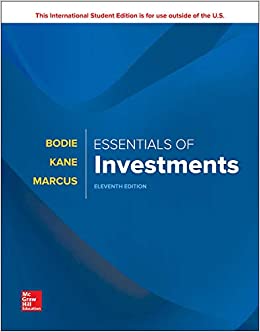Question
1. You buy a share of stock for $35, receive a $2.00 dividend at the end of year one and then sell the stock at
1. You buy a share of stock for $35, receive a $2.00 dividend at the end of year one and then sell the stock at that time for $40. Draw the time line for your CFs. What is your (a) dollar gain or loss; (b) HPR?
2. You purchase an asset for $250 and sell it 4 years later for $300. What is your (a) dollar gain or loss; (b) HPR; (c) simple annualized yield; and (d) compound annualized yield?
3. Make up an example of two different investments where one has a higher dollar gain but a lower HPR.
4. Which type of risk need we not worry about so much and why?
5. You currently hold shares of stock A and are considering adding either stock B or Stock C to your holdings. Make up correlation coefficients between A and B and between A and C and then indicate which stock you should add in order to minimize the risk of your portfolio.
6. Stock A has an expected return of 8% and a standard deviation of 10%. Make up three different sets of values for these two variables for a stock that a rational risk-averse investor would consider to be (a) better than A; (b) inferior to A; and (c) for which the investor would be indifferent between it and stock A.
7. If the MRP is 7 percentage points and the risk-free rate is 2%, what is the expected return on the market?
8. According to CAPM, how would the expected return on a stock with a beta of 1.5 compare to the expected return on the market?
9. You have $75,000 to invest and want to put together a two-asset portfolio consisting of U.S. T-bills and a risky asset. If the risky asset has a beta of 0.95 and you want your portfolio to be only three-fourths as risky as the market, how much should you invest in the risky asset?
10. The Temple University Investment Club has $200,000 to invest in the equity market. Two options are Stock X with a beta of 1.3 and an expected return of 13.7% and Stock Y with a beta of 0.85 and an expected return of 12.8%. Club rules require picking only one of these stocks. Assuming that the risk-free rate is 2.5%, what are the reward-to-risk ratios for the two stocks? Which stock should the Club select and why?
Step by Step Solution
There are 3 Steps involved in it
Step: 1

Get Instant Access to Expert-Tailored Solutions
See step-by-step solutions with expert insights and AI powered tools for academic success
Step: 2

Step: 3

Ace Your Homework with AI
Get the answers you need in no time with our AI-driven, step-by-step assistance
Get Started


